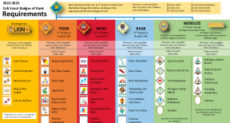 October’s here. Across the great deciduous forests of the north, the leaves are changing and crisp camping weather is here. Sunsets are earlier too, leaving less time to set up camp in daylight and more things for committee chairs to think about as the month progresses.
October’s here. Across the great deciduous forests of the north, the leaves are changing and crisp camping weather is here. Sunsets are earlier too, leaving less time to set up camp in daylight and more things for committee chairs to think about as the month progresses.
The big one that comes around this time of the year for most units is charter renewal. As you probably know, every year we must renew with our local council our charter to operate. The two biggest aspects of the charter renewal process are compiling the membership roster and registration fee collection and payment.
In order to help the process go more smoothly, there are several things to look out for:
- Appoint one committee member to handle the charter process. Often it’s the committee chair’s responsibility to handle this important task, but some units delegate it to another committee member, such as the treasurer or membership chair. The committee chair should maintain oversight over the process and make certain that renewal is on track.
- Keep your membership roster up to date. With the new unit dashboard tools at MyScouting.org (you’ll need the Chrome or Firefox browser to use the site properly), you can easily review your roster as your council has it and compare it against the boys you think are members of your unit. Sometimes a youth application will slip through the cracks and a new member will fail to turn up on your official roster. This is usually due to an application form not making it to your council registrar or some important information missing from the form, but it occasionally happens that forms turned in don’t get keyed in by your council. This step helps to clean up any errors that have crept in.
- Provide your district professional (district director, executive or unit-serving professional) with a copy of your unit roster from your own records (such as Troopmaster, Scout Track or the troop or pack record book). By comparing your roster to what your council has, any errors can be caught early before you begin the recharter process.
- Cub Scout packs usually have a fair amount of turnover as boys join, boys age out and cross over and boys sometimes just stop coming or vanish from your pack for other reasons. By now, you’ve probably had your membership drive and collected everyone’s dues for the coming year, so you’ll know who to re-register well in advance.
- Troops are a bit more stable but there is change that takes place there too. Get a good handle early on about who’s staying and who’s going. Start collecting membership renewals early if you haven’t done so already. And with national registration fees taking a big jump this year (from $15 to $24 a year), you’ll want to make sure you collect enough from your members to cover the increase.
- Keeping track of who’s receiving Boys Life is almost as big a job as keeping the roster current, but make sure those who are expecting a subscription are on record. The simplest way is to automatically send it to everyone, but many units make exceptions for multiple Scouts in a family, or even for opt-out of the magazine despite its value as a program enhancement. Also, be aware that there are different editions for Boy Scouts and Cub Scouts, so if a family has boys in both programs, they should each get their own edition.
- Some councils have adult leader training requirements. Ensure that those for whom training is mandatory have taken the courses they need. If you think you or someone else is trained, check again. You can go on MyScouting and look up the training courses that any registered adult in your unit has taken. You might be surprised to find out (as I was) that a required course that you took ten years ago isn’t shown on your training record. Through MyScouting, you can enter missing training dates for adults in your unit (except yourself – see your council program director for help with your own record).
- Get with your unit commissioner or district professional to find out how to log into your council’s online registration program. Sign in once you’ve cleared your roster with your professional partner. You can make changes in stages if you wish, saving your progress and signing in and out as needed.
- Know and understand the deadline dates. Check your current charter for its expiration date and work back from that. You’ll need to have everything finished, signed and turned in at least two weeks (and preferably a month) prior to your current charter’s expiration. That means finalizing your roster and getting the chartered organization’s executive officer to sign the charter agreement at least thirty days prior to your charter expiring.
- You may need to make an appointment to turn in your charter. Some councils handle turn-ins this way, while in other councils, this can be done on a drop-in basis. Your district professionals could also set up charter turn-in events in various places, particularly if your district is geographically large or you are a great distance from your council’s service center. You may be able to turn it in at Roundtable, or your professional partner could even set up a meeting near you. Check and see what the best approach is.
- Make sure you know what you need to bring to the charter renewal turn-in meeting. You’ll need copies of the printed-out and signed (by the Scoutmaster and chartered organization’s executive officer) charter roster from the online recharter system; the charter agreement signed by your CO’s executive officer; completed and signed application forms for any new youth or adult members (and new adult members need to attach a Youth Protection Training certificate); also YPT certificates for anyone shown on your charter roster as needing one.
- Most importantly, bring a signed blank check, or a check with the council name filled in but the amount left blank. It’s common for the amount that the online chartering system calculates to be different for your council, because many councils include fees for insurance and sometimes additional registration costs. If you absolutely must know the amount in advance, bring everything and have your district professional calculate the fee, then go back to your unit and get a check for that amount.
Charter renewal can be a daunting task, but if you take it a step at a time and allow yourself plenty of time to complete the steps, you can recharter with a minimum of trouble and be off on another year of Scouting.
There is one more thing that’s not part of the recharter process but happens at around the same time, and that’s your annual Journey to Excellence evaluation and submittal. You can usually turn these in starting in October if you have all the information you need. Generally they are due by the end of December, but many councils like to have them a couple weeks before then. Check with your unit commissioner to be sure. He or she should also have access to some of the data that’s needed to calculate your progress, such as membership, retention and advancement, and it’s a good idea to check those against your own figures. Your commissioner also needs to review your final report and sign it, so make sure you don’t wait until the last minute. Keeping in mind that not much will get done in the second half of December because of the holidays, getting this done early will be appreciated by everyone.
Image by arztsaumi / Freedigitalphotos.net
This post first appeared on Bobwhite Blather.




